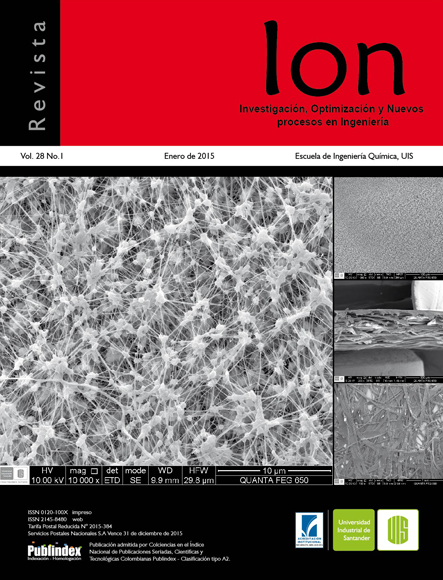Evaluation of ethanol production from potato, cassava and orange wastage in discontinuos cultivation using Saccharomycescerevisiae
Published 2015-07-17
Keywords
- Chemical Hydrolysis,
- Ethanol,
- Waste.
How to Cite
Abstract
The present research aimed to produce ethanol using glucose syrup made from potato, orange and cassava wastage, using discontinuos cultivation as an alternative to handle the wastage generated. In order to meet the main objective two strains of Saccharomyces cerevisiae were used, a native strain (LYP) and control strain (CTL) obtained from the strain stock of the University. Subsequently, for the preparation of the fermentation mediums, the wastage was subjected to a chemical hydrolysis treatment with hydrochloric acid 2 %v, at a temperature of 75 °C for 8 hours, these parameters were selected as a result of statistical analysis of the factorial design 33 which throws statistically significant differences (p≥0.05) in the variables evaluated on the generation of reducing sugars. Finally, 500ml fermentations were performed at 30 °C, 150rpm based in a factorial design 42 in order to evaluate the fermentative substrates and fermenting microorganism, where no significant differences were found (p≥0.05), for both substrates and strains: (CTL) and (LYP), in ethanol production. However, regarding the interactions between the variables, some highly significant differences were found (p≤0.05), the highest production of ethanol obtained was 3.15 and 2.6 % for strains LYP and CLT respectively, when they used the orange syrup and cassava as carbon source.
Downloads
References
[2] Alzate Tamayo LM, Jiménez Cartagena C, Londoño Londoño J. Aprovechamiento de residuos agroindustriales para mejorar la calidad sensorial y nutricional de productos avícolas. Producción + Limpia. 2011;6(1):108-27.
[3] González Fernández J, Molina Córdoba ME. Estudio de los factores que afectan la hidrólisis enzimática y el proceso fermentativo para la producción de alcohol a partir de papa (Solanum tuberosum). Ingeniería Revista de la Universidad de Costa Rica. 2006;16(1):27-37.
[4] Federación Nacional de Biocombustibles. ABC de los Alcoholes Carburantes. (Sitio en internet). Disponible en: http://www.fedebiocombustibles.com/v2/main-pagina-id-5.htm. Acceso 27 de mayo de 2009.
[5] Hernandez Nodorsa M. Tendencias actuales en la producción de bioetanol (Sitio en internet) Facultad de Ingeniería. Universidad Rafael Landívar. Disponible en:http://www.tec.url.edu.gt/boletin/URL_08_ING01.pdf. Acceso el 16 de Julio de 2014.
[6] Arévalo Rodríguez AL, Urbina Suarez NA, Muñoz Peñaloza YA. Aislamiento de levaduras del género Saccharomyces nativas de Norte de Santander para la producción de etanol. En: Ramirez P, Laguado R, editors. VIII Semana de la Ciencia, Tecnología e Innovación; 2012 nov 14-16; Cúcuta, Colombia. Cúcuta: editorial; 2012. p.
[7] Miller GL. Use of Dinitrosalicylic Acid Reagent for Determination of reducing sugar. Anal. Chem. 1959;31(3):426-8.
[8] Yaptenco KF, Hiroaki S, Kojima TT, Tomohiro N, Suzuki T, Takano K, et al. Starch Gelatinization Kinetics in Coled-Stored ‘Danshaku’ Potato tubers (Solanum tuberosum L.). Food Preservation Science. 2000;26(6):315-21.
[9] Cely Illera CV, Velasco Mendoza JA, Celis Mora DA. Evaluación de cinco variedades de caña de azúcar Saccharum oficcinarum (CCSP89259, CC8475, CC8592, SP701284 Y CC87474) promisorias del valle del río Zulia en cuanto a la producción de alcohol etílico a escala piloto (tesis de Pregrado). Cúcuta, Colombia: Universidad Francisco de Paula Santander; 2009.
[10] Kim K, Hamdy MK. Acid hydrolysis of sweet potato for ethanol production. Biotechnology and Bioengineering.1985;27(3):316-20.
[11] Alarcón Elias AV. Producción de Bioetanol con Zymomonas mobilis (tesis de maestría). México D.F., México: Instituto politécnico Nacional; 2010.
[12] Millati R, Niklasson C, Taherzadeh MJ. Effect of pH, time and temperatura of overliming on detoxification of dilute-acid hydrolyzates for fermentation by Saccharomyces cerevisiae. Process Biochemistry. 2002;38:515-22.
[13]Mussatto IS, Roberto CI. Alternatives for detoxification of diluted-acid lignocellulosic hydrolyzates for use in fermentative processes: a review. Bioresource Technology. 2004;93:1–10.
[14] Sossa Urrego D, Navarro Acevedo MA, Matiz Villamil A, Mercado Reyes M, Quevedo Hidalgo B, Pedroza Rodríguez AM. Inmovilización de Bacillus licheniformis y Saccharomyces cerevisiae para la producción de etanol a partir de almidón de papa. Universitas Scientiarum. 2008;13(2):149–61.
[15] Castaño HI y Mejía CE. Producción de etanol a partir de almidón de yuca utilizando la estrategia de proceso sacarificación- fermentación simultáneas (SSF). Vitae Revista de la Facultad de Química Farmacéutica de la Universidad de Antioquia. 2008;15(2):251-8.
[16] Monsalve JF, Medina de Pérez VI, Ruiz Colorado AA. Producción de etanol a partir de la cáscara de banano y de almidón de yuca. Dyna. 2006;73(150):21-7.
[17] Tejada LP, Tejada C, Villabona A, Alvear MR, Castillo CR, Henao DL, et al. Producción de bioetanol a partir de la fermentación alcohólica de jarabes glucosados derivados de cáscaras de naranja y piña. Revista Educación en Ingeniería. 2010;5(10):120-5.
[18] Olsson L, Hahn-Hagerdal B. Fermentation of lignocellulosic hydrolysates for ethanol production. Enzyme and Microbial Technology. 1996;18(5):312-31.
[19] Cantarella M, Cantarella L, Gallifuoco A. Spera A, Alfani F. Comparison of diff erent detoxifi - cation methods for steam-exploded poplar wood as a substrate for the bioproduction of ethanol in SHF and SSF. Process Biochemistry. 2004;39(11):1533–42.
[20] Fonseca Santanilla EL, Oviedo AM, Vargas IJ. Hidrólisis ácida de sustratos agroindustriales colombianos. Umbral Científico. 2006;8:5-11.
[21] Boudarel MJ, Blachere H. Contribution á l’étude de la Fermentation Alcoolique á partir de jus de Betteraves avec. Saccharomyces cerevisiae (tesis doctoral). Dijon, Francia: Université de Dijon; 1994.

